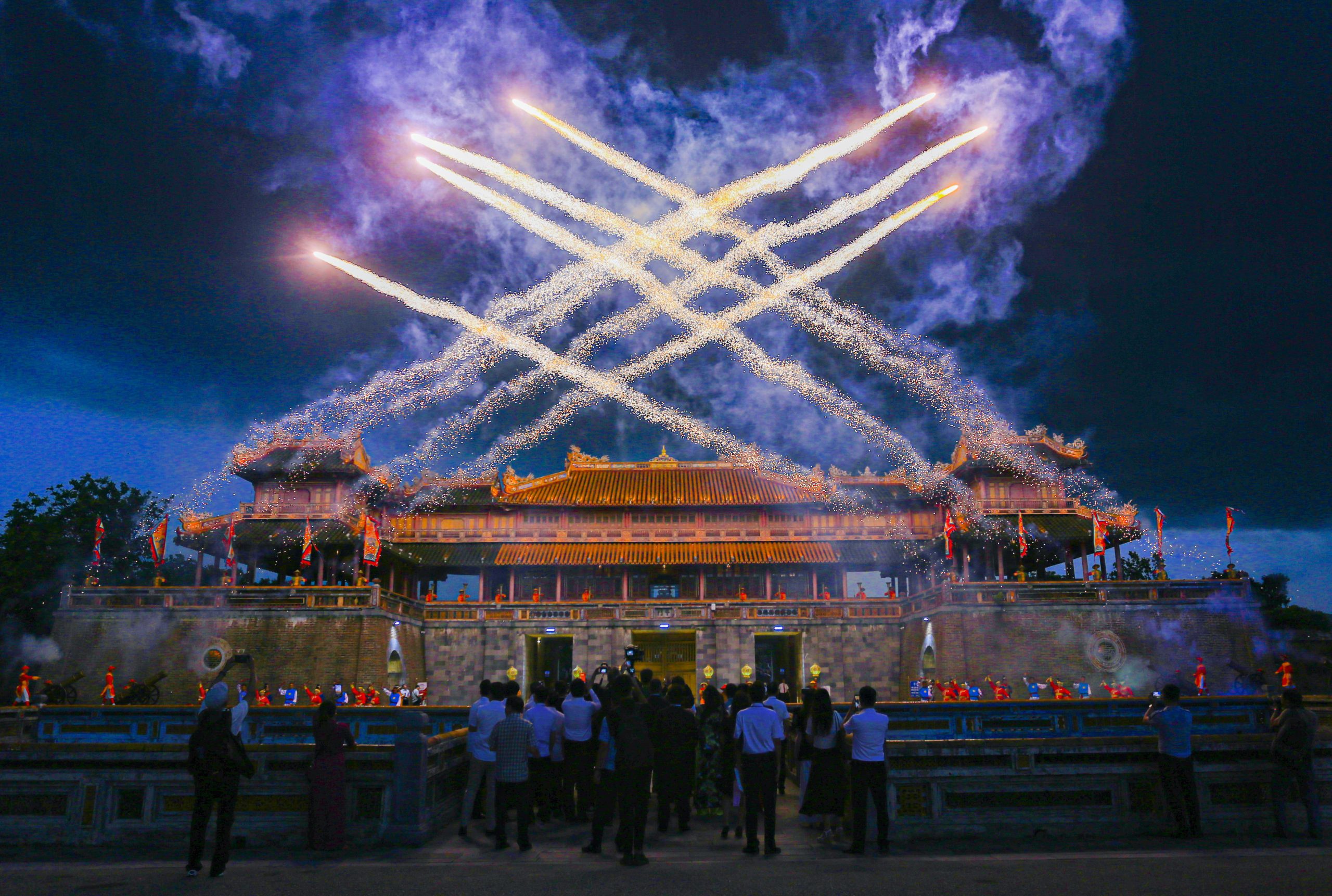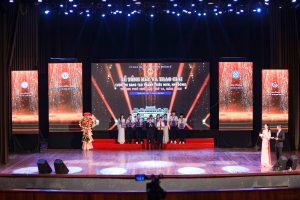Thuy Tien & Thai Hoang
Photos: Anh Tuan
HUSTA
As Hue prepares to launch the National Tourism Year 2025 in just six days, the ancient imperial capital stands at a pivotal moment in its tourism development. The city has strategically positioned itself as a premier cultural destination through international recognition, sustainable initiatives, and a comprehensive events calendar that promises to attract record numbers of visitors. Recent developments and ambitious plans reveal a city poised to transform its rich cultural heritage into a sustainable economic driver while preserving its unique identity.

Art Performance at Hue Imperial City
Hue’s Rising International Profile
Hue’s trajectory in the tourism sector has been marked by significant international recognition, which serves as a foundation for its ambitious goals in 2025. The city’s recent elevation to a centrally-governed status on January 1, 2025, provides substantial advantages for economic and tourism development in the region, offering immense opportunities to promote the city’s image. This administrative change strengthens Hue’s position as it prepares to host the National Tourism Year 2025.
The city has already garnered impressive accolades in the global tourism arena. Hue has secured several ASEAN tourism awards, including recognition as an ASEAN MICE (Meetings, Incentives, Conferences, and Exhibitions) destination. At the same time, local establishments like Silk Path Hotel and Vedana Lagoon Resort & Spa earned “green hotel and resort” distinctions. These awards highlight Hue’s commitment to sustainable tourism practices, a key factor in contemporary destination management.
Particularly notable is Hue’s unique tourism proposition: “One Destination-Five UNESCO recognized world heritages.” This distinctive offering sets Hue apart from other destinations in Vietnam and Southeast Asia, providing visitors with an unparalleled concentration of cultural treasures. The five UNESCO heritage elements encompass the ancient citadel relic complex, Huế royal court music, Nguyễn Dynasty’s wooden blocks, and other cultural treasures that collectively tell the story of Vietnam’s imperial history.

Royal Court Art Performance at Kien Trung Palace, Hue Imperial City
Visitor Demographics and Growth Trajectory
Tourism statistics reveal encouraging growth patterns and diverse visitor demographics that signal Hue’s expanding global appeal. In 2024, Hue welcomed nearly 3.9 million visitors, representing a significant 21.8% increase compared to 2023. International visitors constituted approximately 1.45 million of this total, showing a healthy 16.6% growth compared to the previous year.
The international visitor profile shows a balanced geographic distribution, with Taiwan leading at 11% market share, followed closely by Thailand (10.5%), the United States (8.9%), Malaysia (8.8%), and France (8.1%). The strong representation from ASEAN, Northeast Asia, Western Europe, North America, and Australia demonstrates Hue’s broad international appeal rather than dependence on a single market.
For 2025, Hue has set ambitious yet achievable targets of attracting between 4.8 and 5 million visitors, with international tourists expected to comprise 38-40% of this total. The projected tourism revenue of VND 10.8-11.2 trillion (approximately $425-441 million) would represent a substantial increase from the VND 7.9 trillion ($311 million) generated in 2024.
Strategic Initiatives for Sustainable Tourism Development
Hue’s approach to tourism development reflects a sophisticated understanding of both industry trends and local needs, with sustainability serving as a core principle. The city is implementing multifaceted strategies to ensure that tourism growth supports rather than undermines its cultural and environmental assets.
Green Growth and Cultural Preservation
Recognizing that tourism represents 48% of the city’s gross domestic product while placing significant demands on natural resources, Hue has pioneered initiatives to make tourism sustainable and ecologically responsible. The city has created multi-stakeholder partnerships to explore green-growth strategies, including human-powered alternative transport, garden houses, and eco-tourism promotion.
One particularly successful model has been the development of garden houses, which are cultural relics from Vietnam’s monarchy era. Through public resources such as loan guarantees, these properties have been refurbished to serve as tourist attractions while also providing produce and income for owners and employment for locals who tend the gardens. This approach exemplifies the “win-win” strategies Hue is implementing to reduce emissions and increase income simultaneously.
Tourism authorities are currently developing a comprehensive plan titled “Tourism and tourism service development in Hue City in the 2025-2030 period, with a vision to 2045” with the National Tourism Year 2025 serving as its launching platform. This long-term vision demonstrates Hue’s commitment to strategic rather than opportunistic tourism development.

Restoration at Thai Hoa Palace, Hue Imperial City
Infrastructure and Quality Enhancement
To support its ambitious visitor targets, Hue is prioritizing infrastructure development and service quality improvements. The city is actively calling for investment in 3-5 projects to build 5-star standard hotels and resorts, addressing the need for premium accommodations to attract high-value tourists. This investment drive aligns with the city’s goal of developing 10 five-star hotel establishments in 2025, significantly enhancing its luxury tourism credentials.
The development strategy focuses on restructuring the tourism industry to create a modern, qualified, and sustainable sector. This includes diversifying nighttime activities and culinary experiences along night streets and responding to the growing demand for 24-hour destination experiences that extend visitor stays and increase spending.

Nighttime Activities on the Huong River
National Tourism Year 2025: A Catalyst for Transformation
The National Tourism Year 2025, themed “Hue – the ancient capital, new opportunities,” represents more than just a marketing campaign—it serves as a transformative opportunity for Hue to redefine its position in Vietnam’s tourism landscape and accelerate its development trajectory.
Comprehensive Programming and Strategic Timing
The program features more than 160 national and provincial-level events organized in a thoughtful seasonal approach. The year’s activities will be structured around four main program groups: Spring Festival – “Spring of the Ancient Capital”, Summer Festival – “Citadel Shines” Autumn Festival – “Hue in Autumn” and Winter Festival – “Hue Winter Season”. This seasonal programming ensures year-round visitor engagement, addressing the common tourism challenge of seasonality.
The opening ceremony, scheduled for March 25, 2025—just days away—is themed “A River’s Confession” and will feature high-altitude fireworks and modern technology with a water music system to create novel effects for viewers. This spectacular launch coincides with the 50th anniversary of the liberation of Hue City (March 26, 1975), connecting tourism celebrations with significant historical commemorations.
National and International Engagement
The organizers have designed a truly national event, with the Ministry of Culture, Sports and Tourism, and central agencies organizing eight national-level activities, Hue City organizing 62 activities, and provinces and cities across Vietnam organizing 102 responding activities. This nationwide participation ensures the tourism spotlight extends beyond Hue itself to create collaborative promotional benefits across Vietnam.

International Performing Arts Troupe in Hue
The international dimension is equally robust, with plans to promote the National Tourism Year – Hue 2025 at the EXPO 2025 World Exhibition in Osaka, Japan (April 25 – May 6, 2025). Additionally, promotion in European markets is scheduled for June 2025, targeting key international visitor sources with Vietnamese tourism, cuisine, and craft village experiences.
The Competitive Advantages of Hue Tourism
Analyzing Hue’s position in the competitive tourism landscape reveals several distinct advantages that will likely contribute to its success in 2025 and beyond.
Cultural Density and Authenticity
Few destinations globally can match Hue’s concentration of UNESCO-recognized heritage within a single location. The “One Destination-Five UNESCO heritages” proposition represents exceptional value for cultural tourists seeking authentic experiences. This cultural density allows visitors to immerse themselves in Vietnam’s imperial history efficiently, a significant advantage in an era where time-pressed travelers seek maximum cultural returns on their investments.

Reenactment of the New Year’s Royal Audience Ceremony at the Hue Imperial City
The authenticity of Hue’s cultural offerings is enhanced by initiatives like garden houses, which connect visitors with living traditions rather than staged experiences. This authenticity resonates particularly strongly with contemporary travelers from Western Europe and North America who increasingly seek genuine cultural engagement.
Sustainable Tourism Leadership
Hue’s early adoption of sustainable tourism practices positions it advantageously as global consciousness about environmental impacts continues to grow. The recognition through ASEAN sustainable tourism product awards validates these efforts and appeals to the growing segment of environmentally conscious travelers.
The city’s integrated approach to sustainability—combining conservation, biodiversity protection, and emission reduction—creates a model that distinguishes Hue from competitors who may implement more superficial green initiatives. This comprehensive sustainability commitment creates marketing advantages and operational resilience in the face of climate change challenges.

Visitors enjoy a cyclo ride at Hue City
Conclusion
As Hue stands on the threshold of the National Tourism Year 2025, the city embodies the thoughtful transformation of historical assets into contemporary tourism appeal. The ancient imperial capital has successfully balanced preservation with innovation, creating a distinctive destination proposition that resonates with modern travelers while honoring its cultural legacy.
The strategic initiatives underway—from sustainable development practices to infrastructure improvements and comprehensive event programming—position Hue to not only achieve its ambitious visitor and revenue targets but also to establish lasting competitive advantages in Vietnam’s tourism landscape. The National Tourism Year 2025 represents not simply a calendar of events but a pivotal moment in Hue’s evolution as a world-class destination that successfully marries its ancient capital status with new opportunities.
For tourism investors, operators, and potential visitors, Hue in 2025 offers a compelling combination of cultural immersion, sustainable practices, and innovative experiences that exemplify the future of responsible tourism development in Southeast Asia. As the March 25th opening ceremony approaches, all indicators suggest that Hue indeed deserves its position as the focal point on Vietnam’s 2025 tourism map.








